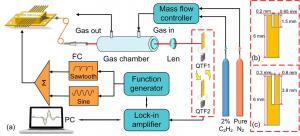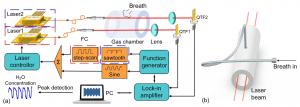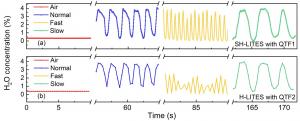LITES technology "speeds up"
A rapid-measurement laser spectroscopy gas sensor based on step heterodyne and high-frequency quartz tuning fork.
CHENGDU, SICHUAN, CHINA, September 12, 2025 /EINPresswire.com/ -- Industrial emissions of sulfur dioxide (SO₂) and nitrogen oxides (NOₓ) in production and daily life contribute to acid rain formation, which degrades soil and aquatic ecosystems while impairing human respiratory health. Gas monitoring technologies enable real-time detection of hazardous gases in the atmosphere, water bodies, and soil, empowering authorities to assess environmental quality and implement effective pollution control measures to safeguard living conditions. These technologies play a critical role across environmental protection, medical diagnostics, and safety surveillance domains.Light-Induced Thermoelastic Spectroscopy (LITES) is a non-contact, high-sensitivity gas detection technique. The principle of this technology is that laser passes through specific gas and irradiates the surface of a quartz tuning fork (QTF), causing its thermoelastic deformation and generating mechanical vibration. The mechanical vibration induces a piezoelectric signal in the quartz crystal, which is used to invert gas concentration. As a photothermal elastic spectroscopy technology, LITES has significant advantages due to its strong specificity, high sensitivity, and full-band spectral detection capabilities. It has become one of the research hotspots in the field of gas sensing in recent years. Current LITES systems still operate on the order of seconds, limiting their applicability in scenarios requiring rapid gas dynamics monitoring, such as chemical reaction analysis, combustion diagnostics, and respiratory gas sensing. Consequently, advancing faster LITES methodologies represents a critical research priority for expanding its utility in dynamic environmental and biomedical applications.
To address the issue of slow measurement speed in current LITES sensing systems, Professor Ma Yufei's team from Harbin Institute of Technology, building on their solid previous research foundation, has innovatively optimized the LITES gas sensing system starting from the response mechanism of QTF. They upgraded the system by adopting heterodyne demodulation, stepwise wavelength scanning, and high-frequency QTF, which significantly improved the measurement speed of the LITES sensor to meet the needs of rapid measurement in dynamic scenarios.
The core innovation employs a high-frequency QTF featuring narrowed tine gaps and shortened tine lengths (Fig. 1b). Unlike standard QTFs, this design achieves a resonant frequency of ~100 kHz. The experimental setup (Fig. 1a) implements heterodyne demodulation, which maintains the QTF in transient response mode rather than steady-state oscillation. This approach reduces detection time from seconds to milliseconds, enables real-time frequency calibration to compensate for environmental drift.
The signal test results of the C₂H₂-LITES sensor indicated that the tailing time of the high-frequency QTF is significantly shorter compared to that of the standard QTF. Through exponential fitting, it is evident that the response speed of the LITES system based on the high-frequency QTF has been improved by approximately 10 times. A complete decay of the QTF signal (with a signal attenuation of 0.1%) can be ensured even when the measurement cycle is only 33 ms. The study further proposes a novel wavelength scanning technique, Step heterodyne light-induced thermoelastic spectroscopy (SH-LITES). In the standard H-LITES technique, a trapezoidal wave is used to scan across the entire absorption line. The SH-LITES technique restricts scanning to the specific wavelength range. This eliminates the need for scanning invalid regions, further shortening the measurement cycle to 15 ms without altering the QTF’s response time.
The system targets H₂O as the gas to be detected, and infers changes in respiratory status by measuring variations in H₂O concentration. The constructed sensor system is shown in Figure 2, which compares the measurement results between the standard QTF-based H-LITES sensor and the high-frequency QTF-based SH-LITES sensor.
Experiments were conducted to measure changes in H2O concentration under four conditions: pure air, normal breathing, rapid breathing, and slow breathing. The results as shown in Fig. 3 indicate that the SH-LITES sensor based on the high-frequency QTF captures more details compared to the H-LITES sensor based on the standard QTF.
This study focuses on improving measurement speed from the perspectives of demodulation methods, wavelength scanning techniques, and detection components QTF, enabling the system to achieve a detection speed at the millisecond level. This advancement will strongly promote the development of light-induced thermoelastic spectroscopy in the field of rapid measurement.
About the Authors:
Yuanzhi Wang obtained his Bachelor's degree in electronic science and technology from Yanshan University in 2023. He is currently pursuing a Master's degree in physical electronics at Harbin institute of Technology. His research mainly focuses on laser spectroscopy technology and its applications.
Ying, He obtained his master and doctorate degrees in physical electronics from Harbin Institute of Technology in 2017 and 2022, respectively. Currently, he is an associate professor at the Harbin Institute of Technology, China. His research interests including trace gas sensing based on QEPAS, LITES and other laser spectroscopy. He has published over 20 academic papers, including 5 ESI highly cited papers, and holds 8 authorized national invention patents. He serves as an editorial board member of Photonics, a guest editor of Microwave and Optical Technology Letters, and a youth editorial board member of PhotoniX, Infrared and Laser Engineering, and Acta Optica Sinica.
Yufei Ma received his PhD degree in physical electronics from Harbin Institute of Technology, China, in 2013. From September 2010 to September 2011, he spent as a visiting scholar at Rice University, USA. Currently, he is a professor at Harbin Institute of Technology, China. He is the winner of National Outstanding Youth Science Fund. His research interests include optical sensors, trace gas detection, laser spectroscopy, solid-state laser and optoelectronics. He has published ~200 publications (including ~70 ESI hot/highly cited papers) and given more than 30 invited presentations at international conferences. He is the winner of 2021, 2022 and 2023 Most Cited Researchers from Elsevier. He serves as area editor for Elsevier Photoacoustics and Wiley Microwave and Optical Technology Letters. He serves as associate editor for Optica Optics Express, SPIE Optical Engineering, and Frontiers in Physics. He also serves as topical editor for Opto-Electronic Advances, CLP Chinese Optics Letters, MDPI Sensors and Applied Sciences.
Read the full article here: http://www.oejournal.org/oea/article/doi/10.29026/oea.2026.250150
Andrew Smith
Charlesworth
+ +44 7753 374162
marketing@charlesworth-group.com
Visit us on social media:
LinkedIn
YouTube
Other
Legal Disclaimer:
EIN Presswire provides this news content "as is" without warranty of any kind. We do not accept any responsibility or liability for the accuracy, content, images, videos, licenses, completeness, legality, or reliability of the information contained in this article. If you have any complaints or copyright issues related to this article, kindly contact the author above.



